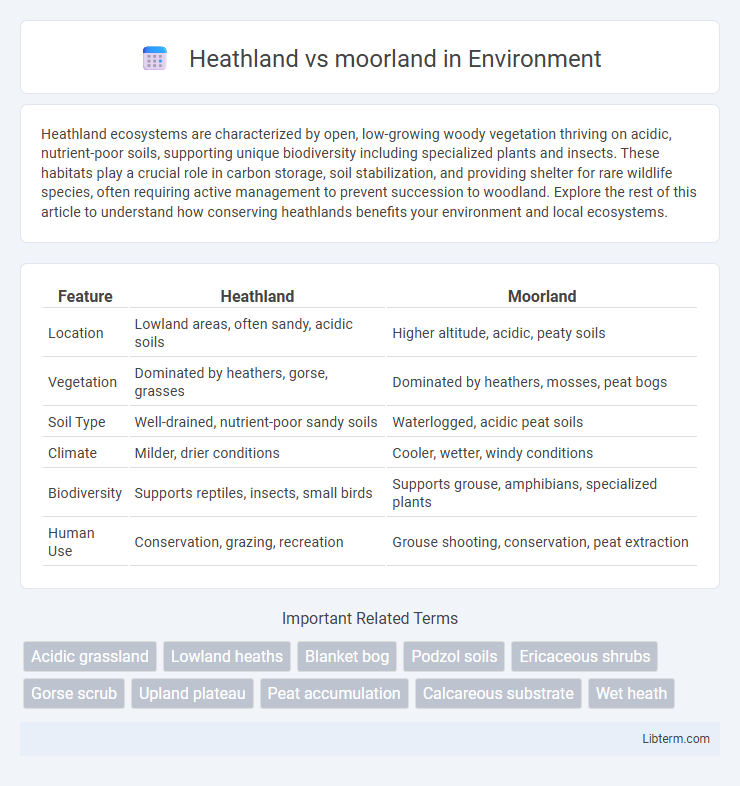Heathland ecosystems are characterized by open, low-growing woody vegetation thriving on acidic, nutrient-poor soils, supporting unique biodiversity including specialized plants and insects. These habitats play a crucial role in carbon storage, soil stabilization, and providing shelter for rare wildlife species, often requiring active management to prevent succession to woodland. Explore the rest of this article to understand how conserving heathlands benefits your environment and local ecosystems.
Table of Comparison
| Feature | Heathland | Moorland |
|---|---|---|
| Location | Lowland areas, often sandy, acidic soils | Higher altitude, acidic, peaty soils |
| Vegetation | Dominated by heathers, gorse, grasses | Dominated by heathers, mosses, peat bogs |
| Soil Type | Well-drained, nutrient-poor sandy soils | Waterlogged, acidic peat soils |
| Climate | Milder, drier conditions | Cooler, wetter, windy conditions |
| Biodiversity | Supports reptiles, insects, small birds | Supports grouse, amphibians, specialized plants |
| Human Use | Conservation, grazing, recreation | Grouse shooting, conservation, peat extraction |
Introduction to Heathland and Moorland
Heathland and moorland are distinct types of open landscapes characterized by low-growing vegetation, with heathland dominated by dwarf shrubs like heather and gorse often found on nutrient-poor, sandy soils. Moorland, typically located in upland areas, features peat-rich soils and supports a variety of grasses, sedges, and mosses alongside heather. Both habitats play crucial ecological roles, supporting unique biodiversity and acting as carbon sinks in temperate regions.
Defining Heathland: Key Characteristics
Heathland is characterized by open, uncultivated land with poor, acidic soils supporting low-growing woody vegetation such as heathers, gorse, and grasses. It typically occurs in temperate regions and features well-drained, nutrient-poor substrates that favor drought-resistant plant species. Unlike moorland, heathlands have less peat accumulation and often support higher biodiversity, especially specialized insects and ground-nesting birds.
Exploring Moorland: Essential Features
Moorland is characterized by its acidic, nutrient-poor soils and dominated by heather, grasses, and mosses, providing a unique habitat for species like red grouse and curlew. Unlike heathland, which often occurs on drier, sandy soils, moorland commonly exists in upland areas with higher rainfall and cooler temperatures. This environment supports important ecosystems essential for biodiversity conservation and carbon storage.
Origins and Historical Development
Heathlands originated mainly on well-drained, acidic, and nutrient-poor soils resulting from Neolithic deforestation and prehistoric agricultural clearance, leading to the dominance of heather and gorse vegetation. Moorlands, often found in upland areas with higher rainfall, developed through a combination of natural climatic conditions and human activities such as grazing and burning, which maintained their open landscapes dominated by peat-forming vegetation like sphagnum mosses. Both habitats have evolved over millennia, reflecting long-term interactions between environmental factors and traditional land use practices.
Vegetation Differences: Flora in Heathland vs Moorland
Heathland vegetation is dominated by low-growing shrubs such as heather (Calluna vulgaris), gorse (Ulex spp.), and bilberry (Vaccinium myrtillus), thriving in nutrient-poor, acidic soils with well-drained conditions. Moorland flora features a mix of heather species, including ling (Calluna vulgaris) and bell heather (Erica cinerea), combined with extensive grasses like purple moor-grass (Molinia caerulea) and sedges adapted to wetter, peatier substrates. The key difference lies in moorland's association with wetter, higher altitude environments supporting grass and sedge proliferation, while heathland prefers drier, lowland acid soils favoring woody shrub dominance.
Wildlife and Biodiversity Comparison
Heathland supports a rich variety of wildlife, including species like the Dartford warbler, smooth snake, and silver-studded blue butterfly, thriving in nutrient-poor, acidic soils dominated by heather and gorse. Moorland ecosystems, often found at higher altitudes, provide habitat for red grouse, merlin, and mountain hare, with biodiversity adapted to wetter, peat-rich conditions and harsher climates. Both habitats contribute significantly to biodiversity conservation, but heathlands typically exhibit greater plant diversity, while moorlands are crucial for specialized upland species and carbon storage through extensive peat layers.
Soil Types and Environmental Conditions
Heathland typically develops on acidic, nutrient-poor, sandy or peaty soils with good drainage, favoring plant species like heather and gorse adapted to dry, well-aerated conditions. Moorland forms on wetter, often peat-rich, acidic soils with poor drainage, frequently found in upland areas exposed to harsh weather, supporting sphagnum mosses and cotton grass. These contrasting soil types and moisture levels create distinct ecosystems, with heathlands thriving on drier, less water-logged substrates, while moorlands depend on water-saturated, peat-forming environments.
Human Impact and Land Management
Heathland and moorland landscapes experience significant human impact through activities such as grazing, controlled burning, and afforestation, which influence biodiversity and ecosystem health. Land management practices aim to balance conservation with sustainable use, including scrub clearance and rewilding efforts to maintain open habitats and support specialist species. Differentiating management approaches is crucial, as heathlands typically require more intensive intervention due to nutrient-poor soils, while moorlands are often managed to preserve peatlands and water regulation functions.
Conservation Challenges and Strategies
Heathland faces conservation challenges such as nutrient enrichment, invasive species, and habitat fragmentation, requiring strategies like controlled grazing, periodic burning, and scrub clearance to maintain its open structure. Moorland conservation struggles with issues including overgrazing, peat erosion, and drainage, leading to the implementation of re-wetting projects, reduced grazing pressures, and heather management to preserve biodiversity and carbon storage. Both ecosystems demand targeted management practices to balance ecological health with land use pressures, ensuring their long-term resilience.
Choosing Between Heathland and Moorland: Ecological Importance
Heathland and moorland each support unique biodiversity, with heathland characterized by dry, acidic soils hosting species like heathers and gorse, while moorland typically features wetter, peaty soils dominated by sphagnum moss and cotton grass. Ecological importance lies in heathland's role as a habitat for rare birds such as the nightjar and Dartford warbler, contrasted with moorland's critical function in carbon sequestration and water regulation through its peat-forming vegetation. Choosing between heathland and moorland conservation depends on regional ecological priorities, emphasizing habitat preservation, carbon storage, or species-specific protection.
Heathland Infographic

 libterm.com
libterm.com